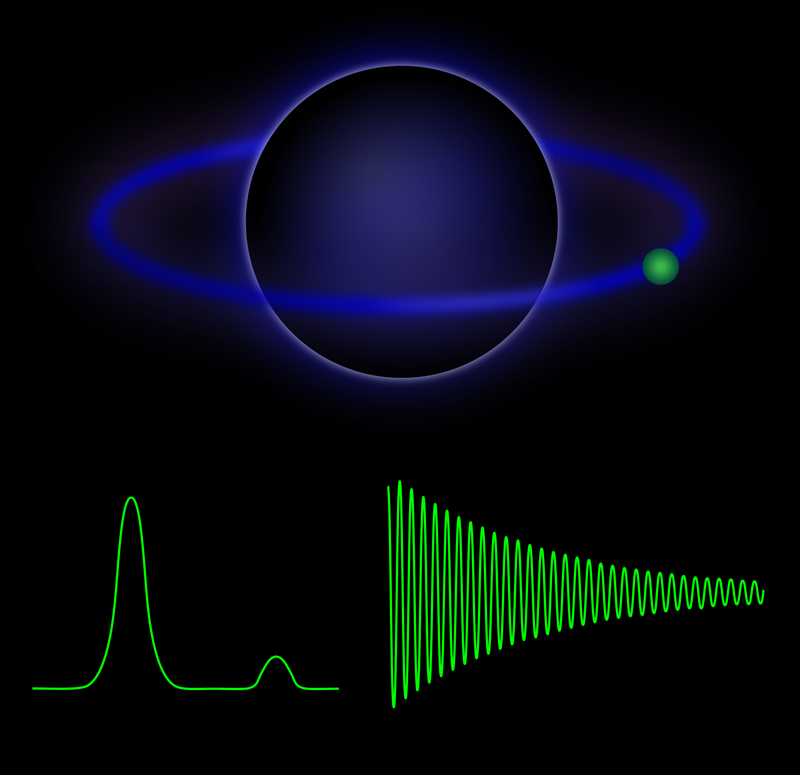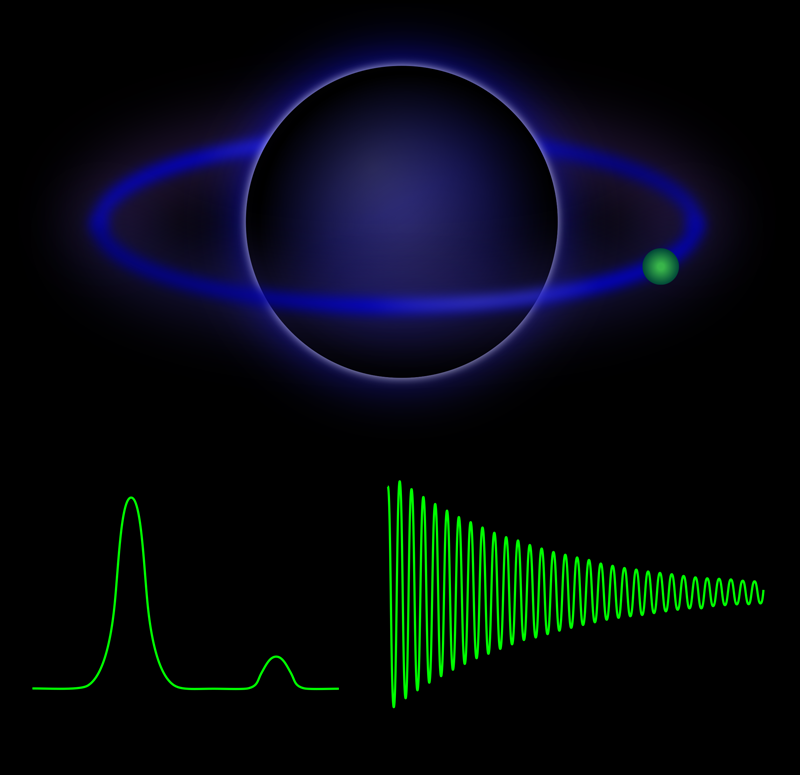Instability in Black Hole Vibrational Spectra
Are black holes stable when they are slightly perturbed? This question was answered 50 years ago by the physicist C. V. Vishveshwara with a numerical experiment: Vishveshwara imagined sending a wave packet toward a black hole and observing what came out [1]. He found that the scattered wave is a sum of damped sinusoids, whose frequencies and damping times are the free-vibration modes, or so-called quasinormal modes, of the black hole. The damping implies that black holes are stable—they settle back into a stationary state after being perturbed. In a new study [2], José Luis Jaramillo from the University of Bourgogne Franche-Comté, France, and colleagues ask another important question: is the black hole quasinormal mode spectrum itself stable? If the black hole environment is perturbed in a small way by, for example, a small accretion disk, will the spectrum of the black hole change by just a tiny bit or by a disproportionally large amount? The surprising answer is that the spectrum may change by a lot, meaning that it is unstable. This instability may have important implications for interpreting gravitational-wave observations and for developing models of quantum gravity.
This is not the first time that the stability of black hole spectra has been called into question. In 1996, Hans-Peter Nollert computed the black hole spectrum from the shape of its scattering potential [3]. Similar computations had been done before, but Nollert took a new approach by approximating the scattering potential in a sequence of discrete steps. The expectation was that these discretized potentials would produce similar spectra to the spectrum of the continuous potential, but curiously, it wasn’t the case. Even worse, the spectra of the discretized potentials did not converge to the spectrum of the continuous potential when the size of the steps became infinitely small.
Intrigued by Nollert’s results, other theorists studied “dirty” black holes—black holes that are surrounded by, for example, a shell of matter or a planet. Here again, they found a mismatch between the spectrum of dirty black holes and that of “clean” black holes in vacuum [4]. Reassuringly, an observer at infinity will see what we would expect based on physical intuition: in the limit where the matter shell is small and located far away from the black hole, the gravitational-wave signal emitted by the black hole approaches the damped sinusoidal response calculated by Vishveshwara [5].
Still, these studies have left researchers wary of the quasinormal modes of a black hole. If the black hole vibrational spectrum is highly sensitive to the presence of a planet or other forms of dirt in its environment, how can they trust that their calculations for black hole dynamics are accurate? A potential clue for resolving this issue can be found in Nollert’s analysis: the spectra of the discretized potentials are similar to the spectra of the so-called w-modes of neutron stars [6]. These w-modes—which exist in general relativity but not in Newtonian gravity—arise from a coupling between the fluid oscillations of the star and the oscillations of the spacetime.
Inspired by the similarity between quasinormal modes and w-modes, Jaramillo and collaborators have turned to the “pseudospectrum” approach, which offers a way to analyze spectral stability. This approach was successfully applied to understand different physical phenomena, including the onset of turbulence in fluid flows moving at high speeds. Turbulence is usually studied by linearizing the equations of fluid flow and looking for unstable modes, but in many cases, the results agree poorly with experiments. Using the pseudospectrum approach, it is possible to explain certain observations of turbulence with a linear mechanism that amplifies small perturbations within a smooth flow, even though all the perturbation modes decay monotonically [7].
Jaramillo and colleagues are the first to use the pseudospectrum in the context of black hole physics. Both the pseudospectrum, which is continuous, and the quasinormal spectrum, which is discrete, can be defined through a linear operator that describes perturbations to the system. Roughly speaking, the quasinormal frequencies are complex frequencies that, when inserted into the linear operator, yield a value of zero. By contrast, the pseudospectrum frequencies are those that return a small (but nonzero) number 𝜖 when inserted into the linear operator. For a stable spectrum, the pseudospectrum frequencies should lie on tiny circles in the complex frequency plane, centered on the unperturbed, discrete points that form the quasinormal spectrum. If, instead, the spectrum is unstable, the circles will “open up” in the complex frequency plane, signaling that any tiny perturbation will push the response of the system very far away from the original quasinormal spectrum.
To compute the black hole pseudospectrum, the researchers use several clever technical tricks, such as a “compactified hyperboloidal approach” that enforces the correct boundary conditions. The key finding of the paper is that all of the so-called “overtones”—frequencies above the fundamental, similar to the higher harmonics of a plucked string—are unstable under perturbations of sufficiently large amplitude and wave numbers. When the perturbation wave number is large enough, the modes migrate toward quasinormal-mode branches that look like w-modes, which explains why Nollert’s perturbed spectra looked like neutron star spectra (a discretization of the original potential corresponds to a spatial perturbation with a certain wave number). One observationally important exception is the fundamental mode, which the researchers find to be stable. This conclusion differs from Nollert’s original study because in the present work, the correct boundary conditions are automatically enforced, while the discretization used in Nollert’s paper led to a different long-distance (low-energy) behavior of the potential.
The mathematical tools introduced in this paper can be used to address many interesting problems in gravitational physics, such as testing Einstein’s theory of general relativity with gravitational waves. Such a test would require the ability to extract different quasinormal modes in the ringdown signal of a black hole merger. By detecting the fundamental mode (including its frequency and damping time), we can determine the mass and spin of a black hole. But if the overtones could be accurately measured, they would provide a test of relativity, as their frequencies are different in different theories of gravity [8]. Further work will need to investigate whether the predicted instability in these overtones will harm our ability to do this type of black hole spectroscopy.
Another important research direction that can be addressed with these tools concerns the apparent lack of nonlinearities in general relativity. Even the most energetic phenomena studied so far in numerical relativity (for example, black hole collisions at the speed of light) do not seem to excite nonlinear effects to observable levels. Perhaps this can be understood by analogy with smooth fluid flows, where small perturbations are amplified by large factors by a linear mechanism, so that nonlinear effects do not play an important role in the onset of turbulence. In fact, some authors proposed the possibility that nonlinear instabilities might appear in rapidly spinning black holes, similar to the onset of turbulence in hydrodynamics [9]. Pseudospectra could be helpful in the study of this “gravitational turbulence” and other black hole phenomena (such as superradiance) that can make black holes unstable.
References
- C. V. Vishveshwara, “Scattering of gravitational radiation by a Schwarzschild black-hole,” Nature 227, 936 (1970).
- J. L. Jaramillo et al., “Pseudospectrum and black hole quasinormal mode instability,” Phys. Rev. X 11, 031003 (2021).
- H.-P. Nollert, “About the significance of quasinormal modes of black holes,” Phys. Rev. D 53, 4397 (1996).
- P. T. Leung et al., “Quasinormal modes of dirty black holes,” Phys. Rev. Lett. 78, 2894 (1997).
- E. Barausse et al., “Can environmental effects spoil precision gravitational-wave astrophysics?” Phys. Rev. D 89, 104059 (2014).
- K. D. Kokkotas and B. F. Schutz, “W-modes: A new family of normal modes of pulsating relativistic stars,” Mon. Not. Roy. Astron. Soc. 255, 119 (1992).
- L. N. Trefethen et al., “Hydrodynamic stability without eigenvalues,” Science 261, 578 (1993).
- V. Cardoso et al., “Parametrized black hole quasinormal ringdown: Decoupled equations for nonrotating black holes,” Phys. Rev. D 99, 104077 (2019).
- H. Yang et al., “Turbulent black holes,” Phys. Rev. Lett. 114, 081101 (2015).





